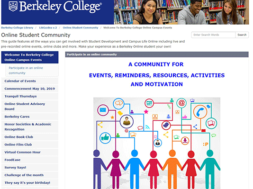
Transitioning and Training Ground Students to Become Exceptional Online Students
By Richard Lombardo, Ph.D., Vice-President of Education and Development, Valley College
Synopsis
Students graduating from traditional ground educational programs are finding themselves stepping into distance education programs as either a first-time college student or, as a returning student in an effort to further their education. However, these same students that may have demonstrated strong results in a traditional brick and mortar setting are now finding themselves struggling with their transition into distance education. Therefore, in an effort to explore how postsecondary institutions can help these students transition from traditional to distance education, this paper will explore the following topics:
- The types and causes of student struggles in distance education
- Characteristics of successful distance education students
- Services offered by institutions to assist with students entering and/or transitioning into distance education and the supporting rationale for offering these services
- Best practices that have a positive impact on retention for distance education students
- A suggested model for institutions to consider in their efforts to help traditional students transition to a distance education program
Background
Moving from a traditional educational setting to an online setting requires an adjustment and might create a series of challenges that the student must be prepared to overcome in order to be successful. For example, Sydney Daniello (2020), a Programs Intern at Mental Health America cites a series of potential challenges for students transitioning to online classes that include difficulty engaging with online material, struggling to pay attention, and lacking motivation to attend class. In addition, many students struggle with the time management and scheduling that comes with being an online student. MacDonald (2014) supports this position when he states that students “need time management strategies and scheduling practices, because in an online environment there are many flexible options” (para. 6).
Unfortunately, far too many students experience these challenges, among other challenges, and struggle to develop a solution. As a result, while enrollment numbers continue to increase, drops also continue to rise.
Currently, online college program enrollments are increasing while in comparison, total college enrollments are down. For example, Abamu (2018) shared data from The Babson Survey Research Group, who reported that “between 2012 and 2016 the percent of online enrollment in universities increased 17.2% while overall enrollment decreased” (para. 2). Therefore, as students continue to enter online college classrooms instead of traditional brick and mortar settings, institutions are faced with the challenge of building a retention model to help students transition into online classrooms and retain them through graduation. The consequences of an ineffective model can lead to declining retention numbers, dwindling populations, and ultimately, missed opportunities to meet the educational needs of our students.
The types and causes for student struggles in distance education
There are many reasons why students struggle and ultimately, drop out of online programs. When analyzing the reasons for these struggles, I have found it advantageous to analyze this information by breaking the challenges down into categories and then, define a series of specific reasons inside of each category. For example, when analyzing the reasons why online students drop, the following five categories can be used to organize the reasons.
- Non-academic/off-campus:
-
- Financial challenges, child-care limitations, housing, medical emergencies, lack of family support, and juggling multiple jobs with school workload.
- Technology:
-
- A lack of technology and/or equipment, or a consistent and reliable internet connection in the student’s place of residence.
- Confidence and experience:
-
- Little to no previous educational success and as a result, lack the confidence or problem-solving skills to effectively combat an academic or retention challenge when it arises. No experience functioning in an online classroom.
- Student behavior and skills:
-
- Minimal experience and skills using technology, low amount of self-directed behavior, inability to effectively communicate, manage time, prioritize, or organize their schedule.
- Institutional support:
-
- Poor enrollment and orientation practices, a lack of personalizing coaching and advising services, minimal online community building, lack of data analysis and performance management tools and practices, and inadequate educational quality and delivery.
Ultimately, each of the categories listed above contributes to retention issues for online students. Further, “there’s no single solution to this but there are strategies, best practices and critical areas the institution could focus on to increase its students’ chances of graduation” (Chooi, 2019, para. 24). Each of these categories present an equal amount of risk to student retention and as Chooi (2019) continues to explain, it is important to understand that “an effective student retention strategy is also holistic, requiring buy-in and the participation of all relevant faculties and departments” (para. 26). Therefore, to establish a strategy to transition and retain first-time online students, one could conclude that each major category described above requires an equal amount of assessment, analysis, and critical evaluation. Now that we have uncovered the challenges that could impact a student’s ability to transition into an online classroom and be successful, let’s shift our attention to gain an overview of the characteristics and skills of a successful online student.
Characteristics of successful distance education students
There are a multitude of reasons as to why an online student is successful. As described in the previous section, it can also be advantageous to analyze this information by breaking down the positives into categories and then identify a series of specific reasons for each category. The following categories and underlying reasons, based on historic performance of online students can be linked to the following several categories:
- Mind-set:
-
- Students have a clear vision as to what they want to accomplish, are motivated to meet their goals, enroll in the appropriate program, and create and remain disciplined to a plan to complete their online program.
- Behaviors:
-
- Students work at a consistent pace that is consumable. Students also have the ability to remain flexible and will adjust their schedule accordingly to account for short and long-term school, personal, and professional needs that evolve over time.
- Student skills:
-
- Students are self-directed, detail oriented, and strong communicators with the ability to use text, email, phone and the LMS features with faculty, staff, and their fellow students. Students have developed and have learned how to manage their time, prioritize deadlines, organize their resources, and think both short and long-term.
- Technology:
-
- Students are either well-versed in technology and/or have worked with the institution that they are joining and fully understand the capabilities and resources offered through the Learning Management System (LMS).
- Resources:
-
- Students have the means to learn using a dedicated computer, understand how to effectively use hand-held devices as a tool for their online learning, and have the ability to rely on a permanent internet service. Students have financial resources or work plans in place, consistent child-care, and family/personal network support and encouragement.
When considering self-motivation, there is a prevailing question that many online program leaders ask, and it is captured by Stansbury (2017), who asks, “typically, only those online students who are self-motivated tend to succeed, but are there other more definable characteristics that characterize the successful online students?” (para. 1). As demonstrated above, and in keeping with a holistic approach to ensure students can successfully transition into an online program, it is the position of this paper that yes, there must be more than self-motivation. However, as opposed to just characteristics, there are skills that must be developed, resources that need to be accessed, and an institution that is able to help facilitate this process. The following section demonstrates examples of the services and tools that institutions have created to help facilitate the positive growth of mind-set, behaviors, skills, and resources for a student as they enter and work their way through an online program.
Services offered by institutions to assist with students entering and/or transitioning into distance education
As illustrated in the previous section, there are a number of characteristics, behaviors, skills, and resources that can challenge or contribute to an online student’s success. However, in order to develop skills and behaviors and provide services to account for either a weak or developing skill, or a lack of resources, there are a number of services and supplemental activities that are consistently being developed and deployed to assist the online student.
Comprehensive package of services and best practices
When considering support and services offered to online students, the Office of Distance Education and eLearning at Ohio State University (2020) illustrate that “at the programmatic level, there are many best practices that can impact student success” (para. 7) and in all, name 11 strategies that range from an in-depth online orientation, a student communication plan, the development of strong advisors, and a series of educational and instructional best practices that must go hand in hand with a retention strategy (Ohio State, 2020). Based on this holistic approach, Ohio State has recognized that it will ultimately take more than motivation to succeed in an online college classroom. Online student success can be linked to the initial and then ongoing development of each of the skills and resources listed above in coordination with sound online educational instructional strategies and meaningful curriculum.
Examples of best practices that are being deployed by institutions around the country to transition and then retain new online students include but are not limited to the following:
- New student orientation that focuses on the use and capabilities of the LMS.
- Online chat and support that focuses on technical, content, and research-based subjects.
- Student portals and course selection tools that also contain student information and records.
- Self-service resources and/or a dedicated student contact to assist with a wide variety of student account needs.
- Academic resources and support personnel available for students struggling with a specific need.
- Supplemental educational tools and resources to improve essential skills to succeed as an online student.
- Notifications and alerts for key actions in a course or, to work with a department in the institution to fulfill a requirement.
- Data analysis tools that are used to measure performance and the overall impact of resources.
- Social media platforms that are used to connect and create an online student community.
- Career Service and job search online resources and activities.
High level/pro-active student advising
In coordination with a high level of comprehensive services described above, institutions are also conducting a much more detailed level of student advising and support. For example, Ohrablo (2016) explains that while a campus-based student may get lost navigating the campus the first time or two trying to find the financial aid or registrar’s office, online students may have a persistent feeling of being lost, as they do not have the opportunity to develop the contextual framework associated with buildings, faces, and in-person referrals (para. 2). Therefore, as opposed to being limited to “hyperlinks and call centers which may keep them on hold for hours” (para. 2), colleges are developing Student Success Coaches, Advisors, or specific departmental staff that are specifically assigned to a group of students. As Ohrabolo (2016) goes on to explain, by working with a specific group of students and understanding the specifics of each student, the advisor can anticipate their needs, monitor progress, and pro-activity communicate (para. 10). This personalized level of support, in turn, assists the first-time online student through their transition period and ultimately gives them the peace of mind that they are not alone but rather, surrounded by those that will support their educational journey.
Data analysis
In correspondence with these resources, institutions are also conducting a high level of data analysis to evaluate where their online students are succeeding and where they are failing. In addition, this data analysis exercise will also verify what resources online students are using and the impact of these resources on academic success and student retention. Utilizing this approach, institutions are able to evaluate the contributions and performance of staff and faculty along with the effectiveness of the package of services that they are offering to help their online students. Ultimately, the data collection and analysis process will help the institution render a decision on either continuing, developing or cutting a student resource in response to the results.
Before determining the continuation, development, or removal of a student resource based on perceived need, online program leaders should also take a deeper look at their student population. This analysis should focus on what students think, their immediate and long-term needs, current skills, and available resources. For example, when building a retention plan for students transitioning into an online program Galanek (2020) takes the position that:
“Identifying which tools students find useful (or not) may aid in assessing whether students are more likely to engage with available technologies that contribute to retention and graduation. If early alerts, for example, are not seen as useful, how likely is it that students will engage with them or follow up with academic support staff? Taking a look at what students and faculty find useful about these tools may offer some insight into whether the tools are valued and, ultimately, whether students and faculty will engage with them.” (para 3).
Using this philosophy, this position will enable online program leaders to focus on a combination of emerging best practices in coordination with the specific feedback, needs, characteristics, and resources of an institution’s student population. This approach will enable institutions to avoid the implementation of a set of services that may not include the needs of their specific campus. Ultimately, this will bring a focused approach and optimize resources that correspond with the needs of an institution’s population.
One size does not fit all
The approach deployed by other postsecondary institutions does not necessarily contain all best practices and may not be specific to the reader’s institution. Therefore, it is essential to create a model that not only accounts for fundamental best practices that have historically proven to have a positive impact on helping transition and retain new online students, but also account for the specific needs of your population. The final section of this paper will present online program leaders with a suggested model to deploy in order to ensure that your strategy for transitioning and retaining new online students corresponds with the needs of your institution and the needs of your student population.
A suggested model for institutions to consider in their efforts to help traditional students transition to a distance education program
This paper has presented a series of key considerations that deal with student challenges and successes when transitioning into an online educational program. This paper has also provided a series of services and corresponding best practices that have been deployed to help students transition into an online program. However, as described above, one series of best practices may not be the best recommendation for one institution versus another.
Therefore, in order to effectively account for the needs of your institution and the needs of your new online students, the following information illustrates a model, and supporting rationale, to build a transition and retention strategy for your new online students. The following model has been broken down into five steps to ensure a holistic approach.
Step 1: Data dive/quantitative and qualitative review
The first step in this model is to conduct a data dive into a series of subjects that have a direct impact on a student’s ability to successfully transition into an online classroom. Goldring and Berends (2008) support this approach when they state that “Today’s effective educational leaders use data extensively to guide them in decision making, setting and prioritizing goals and monitoring progress” (p. 5).
Therefore, at the onset of this process, it is critical to collect, organize, analyze, and evaluate accurate data in order to draw an initial series of observations specific to your online student population.
As described at the beginning of this paper, a suggested series of data points is the series of categories that have a direct link to the challenges and points of success for students transitioning into an online program. This data should be collected from trusted sources of your proprietary data, students, faculty, and your staff. A full-scale analysis should then be deployed to identify trends specific to your online population. These subjects might include; enrollment processes, practices and start rates, financial aid processing and completion, student support services, technology, staff execution of responsibilities, quality of instruction, and placement. Additional student based metrics should include motivations and goals, preferences for resources, skills and behaviors, successes and challenges, student attendance and engagement, academic performance, and placement.
Step 2: Establishing key objectives
Following our data dive, it is essential for the leadership team to come together and establish Key Objectives. These objectives are described by John Doerr (2018) as “simply WHAT is to be achieved, no more and no less. By definition, objectives are significant, concrete, action oriented, and ideally inspirational. When properly designed, they’re a vaccine against fuzzy thinking – and fuzzy execution (p. 7). Using a hypothetical example to bring additional insight to this step, one of several key objectives specific to transitioning new online students into a program could focus on the enrollment process. The objective might state, “Establish a high performing enrollment, orientation, and start process for all first-time online students.”
Objectives should be clear, definitive, and as noted above, state exactly what is to be achieved. In this instance, the objective is to build a high performing process to enroll, orientate, and start all first-time online students. Now that we know where we stand based on our data dive and, WHAT is to be achieved, let’s move to step three, HOW we will get there and achieve the objectives that will help our first-time online students’ transition into their program.
Step 3: Establishing key results to achieve our objectives
It is essential to start this step by sharing the Key Objectives with your team in order to ensure that every department is working together in one unified effort. Once these objectives have been established and communicated, the focus shifts to the Key Results that will need to be executed in order to achieve the Key Objectives. Doerr (2018) states that “KEY RESULTS benchmark and monitor HOW we get to the net objective. Effective KRs are specific and time-bound, aggressive yet realistic. Most of all, they are measurable and verifiable” (p. 7). Results should always include a number to measure and verify progress. Doerr (2018) states that “where an objective can be long-lived, rolled for over a year or longer, key results evolve as the work progresses” (p. 8). The combination of the Key Objectives and now, the Key Results according to Doerr (2018) result in your OKRs.
For example, using the hypothetical Key Objective stated above, we will need to create several Key Results to measure and verify if we are progressing towards or, falling short of meeting our objective. Doerr (2018) explains that setting 3-5 Key Results to support the Key Objective is ideal. Using the Key Objective noted above, which again states, “Establish a high performing enrollment, orientation, and start process for all first-time online students,” we now look at several supporting key results that we will use to drive our efforts and measure progress.
- Key Result 1: Decrease first-time online student enrollment cancellations by 5% in the next three months.
- Key Result 2: Increase successful completion of first-time online enrollee orientation by 10% in the next three months.
- Key Result 3: Increase successful completion of all first-time online enrollee welcome calls with their student advisor before the first day of class by 25% in the next three months.
- Key Result 4: Increase the daily participation rate for all first-time online students by 15% in their first course in the next three months.
- Key Result 5: Increase the pass rate for all first-time online students by 10% in their first course in the next three months.
Each of the Key Results contains a number to measure along with a specific period of time to measure. Goals in this example are achievable and might be something that is carried over again into the following quarter as a set of progressive quarterly Key Results to meet the Key Objective over a longer period of time. In this hypothetical example, the assumption is that through the first step of the data analysis stage described above, the institution recognized that these five areas, defined as Key Results, were contributing to the difficulties of first-time online students. Therefore, in order to successfully achieve the Key Objective, leadership felt that they needed to address these five specific areas.
Finally, using this approach, it is now up to the team to create a tactical plan to execute and communicate with one another at defined checkpoints through the 3-month period of time noted above to measure progress. This approach will enable each department to support one another, remain aligned, and work towards their achieving the Key Objective.
Step 4: Student feedback process, analysis, and evaluation
In accordance with the first three steps described above, and once the first three steps have been started, it is essential that institutional leaders continue to listen to their students on a regular basis as they are working towards their Key Objectives. Institutions can listen to their students in a variety of ways. Students can be heard through direct methods that include periodic surveys, phone calls, polls, discussion threads, and end of class Q&A sessions. Institutions can also listen to their students indirectly through their performance, participation, and behaviors at specific points of their program.
This information should be systematically collected, analyzed, and evaluated with all major departments at regular and defined times as the team pursues their objectives.
The information should encompass subjects that account for their academic and retention based needs, wants, successes, challenges, and overall progress. Explorance (2020) supports this approach as a positive approach for institutions when they state that “when students feel that their voices are being heard and their feedback is being put to good use, they will be more inclined to reciprocate by increasing their attendance, in-class engagement as well as the quality, quantity & usefulness of the feedback that they provide” (para. 8).
Moving back once again to our hypothetical example, institutional leaders can take the three-month period of measurement to manage results and periodically collect information from students both directly and indirectly to ensure that they have a balanced collection of data to help them understand how their key results are evolving and how specific activities and initiatives are being received at the student level.
Step 5: Strategic plan evaluation
Building on the first four steps introduced in this suggested model, the final step involves the establishment of Standard Points of Evaluation “SPE” that correspond with the timelines established with your Key Results. In this step, institutional leadership is evaluating results and objectives with a focus on execution, student, faculty, and staff performance, key data points identified as part of the step one process described above, and an evaluation as to whether or not progress has been made in pursuit of the Key Objectives. Processes, procedures, and other key variables associated with execution should also be evaluated and openly discussed to determine progress. Each major department leader should be present at these evaluation points and given an opportunity to contribute. At this stage, adjustments could be made, new Key Objectives and Key Results could be set, or continued efforts might be extended.
Institutional and departmental leadership as a whole should leave the SPE with a full understanding of the results, new or adjusted Key Objectives, and/or adjusted Key Results along with the supporting data and rationale to support the approach. Your departmental leaders are then tasked with leading their respective teams and continuing to communicate with institutional leadership and one another. The 5-step model does not cease but rather, is a model that continues to cycle in an effort to achieve continuous improvement and in the case of our hypothetical example, improve the ability of our first-time online students to transition and ultimately graduate from their online program.
References:
- Abamu, J. 2018. The Number of Students Taking Online Courses is Quickly Rising, But Perceptions are Closing Changing Slowly. Ed-Surge.com. https://www.edsurge.com/news/2018-06-12-the-number-of-students-taking-in-online-courses-is-quickly-rising-but-perceptions-are-changing-slowly
- Chooi, C. 2019. Strategies to boost student retention every college & university must know. Online Business Education. https://u2b.com/2019/09/27/strategies-to-boost-student-retention-every-college-university-must-know/
- Daniello, S. 2020. A College Student’s 7 tips for Transitioning to Online Classes. Mental Health America. https://www.mhanational.org/blog/college-students-7-tips-transitioning-online-classes
- Doerr, J. 2018. Measure What Matters. How Google, Bono, and the Gates Foundation Rock the World with OKRs. Portfolio/Penguin.
- Explorance. 2020. 4 Ways Regular Student Feedback Strengthens Student Retention. https://explorance.com/blog/4-ways-regular-student-feedback-strengthens-student-retention/
- Galanek, Joseph. 2020. Rating the Usefulness of Student Success Tools. Educase Review. https://er.educause.edu/blogs/2020/4/rating-the-usefulness-of-student-success-tools
- Goldring & Berends. 2008. Leading with Data. Pathways to Improve your School. 1st Edition. Corwin.
- MacDonald, J. 2014. Transitioning to Online Education: It’s More Than Just Computers. Evolution.com Teaching and Learning. https://evolllution.com/opinions/transitioning-online-education-its-computers/
- Ohio State University. 2020. Student Success: Retention Best Practices for Programs and Faculty. Office of Distance Education and eLearning Resource Center. https://resourcecenter.odee.osu.edu/course-design-and-pedagogy/student-success-retention-best-practices-programs-and-faculty
- Ohrablo, Ed.D., S. 2016. Advising Online Students: Replicating Best Practices of Face-to-Face Advising. NACADA Clearinghouse. https://nacada.ksu.edu/Resources/Clearinghouse/View-Articles/Advising-Online-Students-Replicating-Best-Practices-of-Face-to-Face-Advising.aspx
- Stansbury, M. 2017. 10 attributes of successful online students. eCampus News. https://www.ecampusnews.com/2017/05/01/attributes-online-students/
DR. LOMBARDO began his career in the financial services industry were over the first 14 years of his career, he developed the ability to build an operational infrastructure that matched the goals and objectives of the organization and enabled the organization to fulfill their ability to develop and deliver various types of products and services. During this time, Dr. Lombardo also developed the ability to develop and drive new business development initiatives and lead a multitude of projects, which included the training and ongoing employee development to ensure the effective design and sustained delivery of various financial products and services.
In 2010, Dr. Lombardo moved exclusively to postsecondary education while obtaining an MBA in Management and a Ph.D. in Adult Education and Professional Services. During the last decade, Dr. Lombardo developed into a highly accomplished educational executive that has demonstrated an impressive and extensive record of achievement delivering strategic leadership in the design, development and delivery of educational/training programs that consistently deliver exceptional results in student engagement, retention, student placement, satisfaction, and student success.
In addition, Dr. Lombardo has developed an assortment of operational training and educational programs delivered via digital, online, and traditional means that optimize engagement and staff/student experience through the adoption of blended learning methodologies. Finally, based on these efforts, Dr. Lombardo has been recognized for his capacity to cultivate and strengthen internal collaborative partnerships across multiple departments.
Contact Information: Dr. Richard Lombardo, Ph.D. // Vice-President of Education and Development // Valley College // 856-220-0634 // rlombardo@valley.edu // www.valley.edu // https://www.linkedin.com/in/richard-lombardo-ph-d-8606986/








